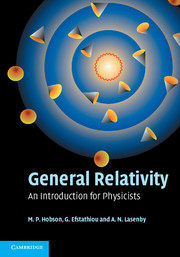Book contents
- Frontmatter
- Contents
- Preface
- 1 The spacetime of special relativity
- 2 Manifolds and coordinates
- 3 Vector calculus on manifolds
- 4 Tensor calculus on manifolds
- 5 Special relativity revisited
- 6 Electromagnetism
- 7 The equivalence principle and spacetime curvature
- 8 The gravitational field equations
- 9 The Schwarzschild geometry
- 10 Experimental tests of general relativity
- 11 Schwarzschild black holes
- 12 Further spherically symmetric geometries
- 13 The Kerr geometry
- 14 The Friedmann–Robertson–Walker geometry
- 15 Cosmological models
- 16 Inflationary cosmology
- 17 Linearised general relativity
- 18 Gravitational waves
- 19 A variational approach to general relativity
- Bibliography
- Index
2 - Manifolds and coordinates
Published online by Cambridge University Press: 05 September 2012
- Frontmatter
- Contents
- Preface
- 1 The spacetime of special relativity
- 2 Manifolds and coordinates
- 3 Vector calculus on manifolds
- 4 Tensor calculus on manifolds
- 5 Special relativity revisited
- 6 Electromagnetism
- 7 The equivalence principle and spacetime curvature
- 8 The gravitational field equations
- 9 The Schwarzschild geometry
- 10 Experimental tests of general relativity
- 11 Schwarzschild black holes
- 12 Further spherically symmetric geometries
- 13 The Kerr geometry
- 14 The Friedmann–Robertson–Walker geometry
- 15 Cosmological models
- 16 Inflationary cosmology
- 17 Linearised general relativity
- 18 Gravitational waves
- 19 A variational approach to general relativity
- Bibliography
- Index
Summary
Our discussion of special relativity has led us to model the physical world as a four-dimensional continuum, called spacetime, with a Minkowski geometry. This is an example of a manifold. As we shall see, the more complicated spacetime geometries of general relativity are also examples of manifolds. It is therefore worthwhile discussing manifolds in general. In the following we consider general properties of manifolds commonly encountered in physics, and we concentrate in particular on Riemannian manifolds, which will be central to our discussion of general relativity.
The concept of a manifold
In general, a manifold is any set that can be continuously parameterised. The number of independent parameters required to specify any point in the set uniquely is the dimension of the manifold, and the parameters themselves are the coordinates of the manifold. An abstract example is the set of all rigid rotations of Cartesian coordinate systems in three-dimensional Euclidean space, which can be parameterised by the Euler angles. So the set of rotations is a three-dimensional manifold: each point is a particular rotation, and the coordinates of the point are the three Euler angles. Similarly, the phase space of a particle in classical mechanics can be parameterised by three position coordinates (q1, q2, q3) and three momentum coordinates (p1, p2, p3), and thus the set of points in this phase space forms a six-dimensional manifold. In fact, one can regard ‘manifold’ as just a fancy word for ‘space’ in the general mathematical sense.
- Type
- Chapter
- Information
- General RelativityAn Introduction for Physicists, pp. 26 - 52Publisher: Cambridge University PressPrint publication year: 2006



